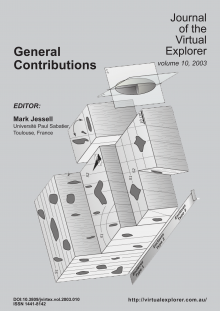- Home
- Journal
- 2017 -- 50, 51
- 2016 -- 49, 50
- 2015 -- 48
- 2014 -- 46, 47
- 2013 -- 44, 45
- 2012 -- 40, 41, 42, 43
- 2011 -- 37, 38, 39
- 2010 -- 35, 36
- 2009 -- 31, 32, 33, 34
- 2008 -- 28, 29, 30
- 2007 -- 25, 26, 27
- 2006 -- 21, 22, 23, 24
- 2005 -- 18, 19, 20
- 2004 -- 14, 15, 16, 17
- 2003 -- 10, 11, 12, 13
- 2002 -- 6, 7, 8, 9
- 2001 -- 3, 4, 5
- 2000 -- 1, 2
- Editorial Board
- Policies
2003 Issues
Edited by:
General contributions in 2003 included a rebuttal of subduction geology for the Italian peninsula, and a discussion of pronged enclaves.
Edited by:
The Himalaya is considered as a typical example of continent-continent collision between the Indian and Eurasian Plates during Cenozoic time. The Himalayan collision zone contains various granitoids with ages ranging from Proterozoic to Recent. These granitoids can be classified into two (2) main type related to the orogeny or can be divided into five (5) main types on the basis of their varied geographical distribution in diverse stratigraphic and tectonic setup as linear belts parallel to orogen. Dating of Himalayan granites has generated some of the first order data required to understand crustal growth history of the Indian Plate since Paleo-Meso Proterozoic. The time of crystallisation has been constrained mostly by Rb-Sr whole rock isochron analysis and zircon and monazite U-Th-Pb dating techniques.
Contributions include consideration of granitoids from North Pakistan, paradoxical aspects of the Himalayan granites, imprinted Pan African granitoids, a melting mechanism for Himalayan leucogranite, and source characterization and a possible emplacement mechanism.
Edited by:
This volume takes a journey through various aspects of Indian geophysics, including 4D-modeling, deep seismic sounding, magnetotellurics in the Deccan Volcanic Province, seismic tomography of earthquake sources, crustal structure from aeromagnetic data, geology from geophysics,
crustal section of the North-Western Himalaya, palaeomagnetic studies, and the impact of mantle plumes.
Edited by:
This volume provides contributions linking tectonics studies with geochronology, including new constraints on the timing of tectonic activity in the Pilbara, argon dating of sediments from the Alps, consideration of what determines a crystallisation versus a cooling ages of white mica, and improved Rb-Sr geochronology of disequilibrated rocks from zones of alteration and deformation.



